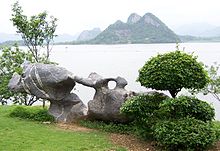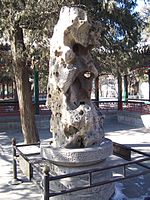- Chinese scholar's rocks
-
Chinese scholar's rocks 
Yingde rocks, a type of scholar's rock Chinese 供石 Transcriptions Mandarin - Hanyu Pinyin gòngshí Cantonese (Yue) - Jyutping gung1 sek6 Chinese scholars' rocks or Gongshi (Chinese: 供石; pinyin: gōngshí), also known as scholar stones or viewing stones, are small shaped or naturally occurring rocks appreciated by Chinese scholars from the Song dynasty onwards, and quite frequently found in traditional Chinese gardens.
The most highly regarded stones are lingbi rocks (Chinese: 灵璧; pinyin: língbì) from Lingbi County of Anhui Province, with the finest examples dating from the Ming dynasty and Song dynasty. Taihu rocks are also prized, and are commonly used as garden stones. They influenced the development of Korean suseok and Japanese suiseki aesthetics and styles and were an important part of Confucian art.
Contents
Stone appreciation
 Summer Palace rock
Summer Palace rock
Natural stone and rock formations, with no artificial carvings, are preferred. Rocks would sometimes be carved and then thrown back into a lake so that any markings could be washed away. Scholars rocks can be any color, and contrasting colors are not uncommon. Sometimes they feature painted patterns, which can be of any subject, either natural or abstract. The size of the stone can also be quite varied: scholars rocks can weigh either hundreds of pounds or less than one pound. Subtlety of color, shape, and markings is also desired, as is beauty of texture and shape. Scholars stones are usually reminiscent of someone or something, or it may convey a spiritual nature that moves viewers in some way. They are usually set upon a stable surface, such as a rosewood pedestal that has been carved specifically for the stone.
By the Tang dynasty, a set of four principal aesthetic qualities for the rocks had emerged consisting of: thinness (shou), openness (tou), perforations (lou), and wrinkling (zhou).[1]
See also
- Penjing
- Suseok
- Suiseki
- Chinese garden
- Floral Arrangement
- Lake Tai - source of many Chinese scholar's rocks
References
- Little, Stephen, Spirit stones of China, the Ian and Susan Wilson collection of Chinese stones, paintings, and related scholars' objects, Chicago, Art Institute of Chicago, 1999, ISBN 0865591733
Footnotes
External links
- Visuals and examples of scholar rocks
- Galleries of scholar rocks
- Books on scholars' rocks
- Chinese scholar's rock history, an introductory historical background
- Classification of Chinese scholar's rocks

This sculpture article is a stub. You can help Wikipedia by expanding it.

